
London Bridge is a central London railway terminus and connected London Underground station in Southwark, south-east London. It occupies a large area on three levels immediately south-east of London Bridge, from which it takes its name. The main line station is the oldest railway station in London fare zone 1 and one of the oldest in the world having opened in 1836. It is one of two main line termini in London to the south of the River Thames and is the fourth-busiest station in London, handling over 50 million passengers a year.

Greenwich station is about 400 m south-west of the district centre, in London, England. It is an interchange between National Rail between central London and Dartford, and the Docklands Light Railway (DLR) between Lewisham to the south and Docklands and the City of London. It is in Travelcard Zones 2 and 3.
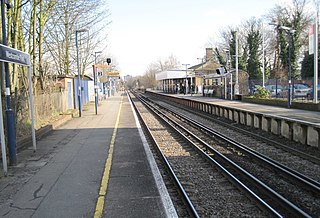
Westcombe Park station is in Greenwich, London, and is situated on the Greenwich Line connecting suburbs along the south side of the River Thames with central London stations.

Lewisham is an interchange station in Lewisham, south-east London for Docklands Light Railway (DLR) and National Rail services.
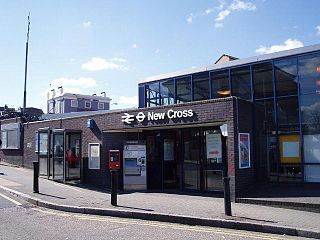
New Cross railway station serves New Cross in south-east London, England. It is 4 miles 68 chains (7.8 km) down the line from London Charing Cross and is in London fare zone 2. The platforms are lettered rather than numbered to avoid confusion with those at New Cross Gate by staff who worked at both stations before privatisation of the stations in 1997. Platform D is used exclusively by London Overground services. Ticket barriers control access to all platforms.

Dartford railway station serves the town of Dartford in Kent, England. It is 17 miles 12 chains (27.6 km) down the line from London Charing Cross. Train services from the station are operated by Southeastern and Thameslink. Southeastern also manages the station. Dartford is a major interchange station in the North Kent region of the Southeastern network. Ticket barriers control access to the platforms.

Catford Bridge railway station is on the Mid-Kent Line, serving Hayes line trains from London to Hayes. It lies between Ladywell and Lower Sydenham stations, 7 miles 42 chains (12.1 km) from London Charing Cross and in Travelcard Zone 3. It is adjacent to Catford railway station on the Catford Loop line. The station entrance is on Catford Road, a part of the South Circular Road (A205), and has brick buildings on both platforms, though the up side building is no longer in use by the railway. The station is managed by Southeastern, who operate all trains serving it.

Eltham railway station is in the Well Hall area of Eltham, South East London, within the Royal Borough of Greenwich. It is 10 miles 68 chains (17.5 km) measured from London Victoria. It is in Travelcard Zone 4.

The Bexleyheath line runs for 8 miles (13 km) from Lewisham to Dartford in Kent. It separates from the North Kent Line just to the east of Blackheath Station, and rejoins the same line just south of Slade Green near Dartford.

Charlton railway station is a railway station in Charlton, Royal Borough of Greenwich. It is 7 miles 44 chains (12.2 km) measured from Charing Cross. The station is operated by Southeastern. Trains serving the station are operated by Southeastern and Thameslink. It is in Travelcard Zone 3.

The North Kent Line is a railway line which branches off the South East Main Line at St Johns junction west of Lewisham station in Greater London and runs to Rochester Bridge Junction near Strood, Medway where it links to the Chatham Main Line.

St Johns railway station is in the London Borough of Lewisham. It lies 5 miles 47 chains (9.0 km) down the South Eastern Main Line from London Charing Cross, and is situated between New Cross and Lewisham.

New Beckenham railway station serves Beckenham in the London Borough of Bromley in south-east London, in Travelcard Zone 4. It is 9 miles 44 chains (15.4 km) measured from London Charing Cross.

Hither Green is a railway station located in Hither Green in the London Borough of Lewisham, south-east London. It is 7 miles 16 chains (11.6 km) down the line from London Charing Cross and is situated between Lewisham and either Grove Park or Lee depending on the route.
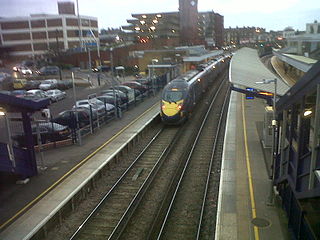
Gravesend railway station serves the town of Gravesend in north Kent, England. It is 23 miles 75 chains (38.5 km) down the line from London Charing Cross.

Strood railway station serves the town of Strood in Medway, England. It is on the North Kent Line and is also a terminus of the Medway Valley Line. It is 31 miles 11 chains (50.1 km) down the line from London Charing Cross.

Gillingham railway station is on the Chatham Main Line in England, serving the town of Gillingham, Kent. It is 35 miles 75 chains (57.8 km) down the line from London Victoria and is situated between Chatham and Rainham.
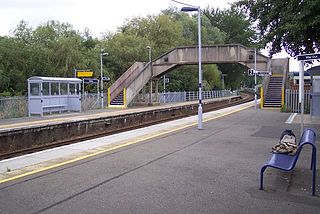
Chilham railway station is a railway station in Chilham, Kent. It is on the Ashford to Ramsgate line between Ashford International and Canterbury West. The station, and all trains serving it, are operated by Southeastern.
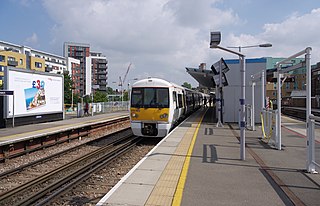
The Greenwich line is a short railway line in South London that follows part of the route of the London and Greenwich Railway, which was the first railway line in London.
Transportation needs within the county of Kent in South East England has been served by both historical and current transport systems.




















